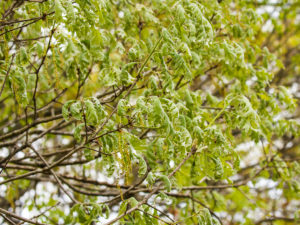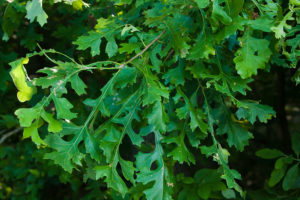This article was first published on the Xerces Society’s blog in March 2022 and is reprinted with permission.
By Emily May
With spring weather just around the corner across the Midwest and northeast US, I have my eyes peeled for woody plants to start blooming and bees to start flying. As you watch backyard plants and trees green up and leaf out, it’s also time to start observing those plants for symptoms of injury from herbicide drift. Pre-planting herbicide applications start early in spring to control winter annual weeds in row crops like corn and soybean, and are followed by over-the-top applications in crop fields after planting and into mid-summer.
Over the past five years, many trees and broadleaf plants in backyards, on farms, and in natural areas across the Midwest have been injured by drift from volatile plant growth regulator herbicides such as dicamba and 2,4-D. These herbicides can volatilize (turn from liquid to gas) and move off-site in the warmer air temperatures later in spring and early summer. Herbicide drift damage can occur hundreds of yards outside of the crop fields where these chemicals are applied, threatening the health of vulnerable crops and wild plants, as well as the pollinators and other wildlife that depend on those plants for food and shelter.

White oak (Quercus alba) showing symptoms indicative of herbicide drift injury during its flowering period in mid April. Oaks are important plants for wildlife, providing food and shelter to birds, small mammals, and many invertebrate species. Photo courtesy of Prairie Rivers Network.
Incident reporting provides important evidence that the US Environmental Protection Agency (EPA) will consider in reviewing and revising pesticide label restrictions and registrations, and that conservation organizations like Xerces and our partners can use to advocate for greater protections. Yet the vast majority of plant injury from herbicide drift – especially damage to non-crop plants in backyards and natural areas – goes unreported. In December 2021, EPA released a memorandum summarizing thousands of dicamba-related incident reports from the 2021 growing season – but despite the breadth of reported injuries, EPA estimated that incidents were still underreported by approximately 25-fold! There are many reasons for this underreporting detailed in our report Drifting Toward Disaster: How Dicamba Herbicides are Harming Cultivated and Wild Landscapes.
If you aren’t familiar with herbicide injury symptoms, you are not alone! Let’s dive into what symptoms to look for on plants, and how to report potential herbicide drift injury to your state pesticide regulatory agency. With your help, we can better understand the geographic range and severity of risk that these volatile herbicides are posing to wildlife habitat, backyard plants, and specialty crops, and can use this evidence to continue to advocate for greater protections.

The cupping exhibited by these American sycamore leaves is characteristic of exposure to growth regulator herbicides like dicamba and 2,4-D. American sycamores (Platanus occidentalis) are particularly vulnerable to drift level doses of these herbicides. Photo courtesy of Prairie Rivers Network.
Symptoms of Herbicide Drift Injury: What to Look For
Even small drift-level doses of plant growth regulators like dicamba and 2,4-D can affect plant growth. Some of the more obvious symptoms of potential herbicide injury on trees and other broadleaf plants include stunted, curled, and/or “cupped” leaves. Cupped and curled leaf margins may bend up or down, and could be accompanied by other symptoms such as twisting or unnatural narrowing and elongation of leaves, or color changes on the leaf edges. Sometimes, herbicide disturbance may cause leaves to grow faster on their upper surface than the underside, resulting in downward bending and twisting of the growing leaf, a symptom known as “epinasty”.

Some herbicide drift injury can be subtle, like the unnatural elongation, or “strapping,” of these burr oak (Quercus macrocarpa) leaves. It can be helpful to compare your observations with reference images of normal leaf shapes. Photo credit: Martin Kemper, Prairie Rivers Network.
Particularly vulnerable tree species include American sycamore, Eastern redbud, a variety of oak species, dogwoods, elms, ash, box elder, and fruit trees like peaches and apples. Sensitive crops include soybeans and cotton that are not resistant to dicamba or 2,4-D, other legume crops, tomatoes, peppers, grapes, sweet potatoes, melons, and brassicas.
For more examples of symptoms and a gallery of healthy vs. affected leaf images from different species, visit the Prairie Rivers Network photo library of symptoms, or watch their video on recognizing symptoms of growth regulator herbicide drift.
How to Monitor and Report Suspected Herbicide Damage
The key to monitoring and reporting herbicide drift damage is documentation! At a minimum, you can take photos of any suspected symptoms of herbicide drift injury, and document the date of observation, location, species (if known) and a description of what you’ve observed on the plant(s). Photos should show the injury symptoms on the affected portion of the plant. It can be helpful to take photos from close up and farther away, and to describe and take photos of nearby plants that appear to be unaffected or also show symptoms. A diversity of plant species in the vicinity showing symptoms can help confirm that the plant injury has resulted from an herbicide drift event.
Note that it can take several days up to several weeks for plants to show the full extent of injury from certain herbicides. Visual observations made immediately after a nearby herbicide application may not show the full extent of symptoms; it can be helpful to observe and document changes over time!
Drift can result from more than one source and can occur hundreds of yards from the site of application, but if you suspect a specific source, document all possible information related to the suspected drift, including proximity to treated fields and dates of known application. If you plan to seek reimbursement for crop or property damages, reporting may need to occur within a short window of time after the observation was first made; check with your respective state pesticide regulatory agency.
Herbicide incident reports can be filed at the Ecological Pesticide Incident Reporting portal, which sends information directly to EPA, and with your state pesticide regulatory agency. Every state has an agency that enforces pesticide regulations and responds to incidents and complaints, and each of these agencies will have a slightly different format for reporting incidents. Some states have an official web-based complaints form, while in other states you will need to contact and file complaints with agency staff. You can navigate to the website and contact information for your state regulatory agency here. Consider reporting suspected drift incidents in both the EPA portal and with your state agency, to ensure that all agencies have the relevant information.
Reporting symptoms of herbicide damage helps us better understand the extent of impacts from these chemicals and builds the evidence base for protecting wildlife habitat. We encourage you to share this information with your friends and neighbors.
Further reading
Learn more about the Xerces Society’s Pesticide Program.
Download a copy of our report, Drifting Toward Disaster: How Dicamba Herbicides are Harming Cultivated and Wild Landscapes
About the Author
Emily May is a Pollinator Conservation Specialist with the Xerces Society’s Pesticide Program. She received a master’s of science in entomology from Michigan State University, and has studied pollinator habitat restoration, bee nesting habits, and the effects of pest management practices on wild bee communities. Her work with Xerces since 2015 has focused on supporting crop pollinators through habitat creation and protecting bees and other beneficial insects from pesticides.
***
Each author appearing herein retains original copyright. Right to reproduce or disseminate all material herein, including to Columbia University Library’s CAUSEWAY Project, is otherwise reserved by ELA. Please contact ELA for permission to reprint.
Mention of products is not intended to constitute endorsement. Opinions expressed in this newsletter article do not necessarily represent those of ELA’s directors, staff, or members.

 Pollinator Conservation Specialist
Pollinator Conservation Specialist